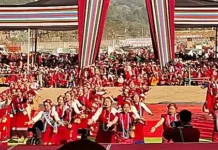[Tado Karlo]
About half a century ago, two historic events took place: one on the moon and the other on Earth. From the moon, three Americans saw Earthrise in the year 1968. On Earth, a year later, the tribes of Arunachal Pradesh saw the sun of democracy rise over the horizon of the NEFA.
The NASA sent men to the moon in 1968, and they captured the first ever spectacular view of the Earth rising over the horizon of the moon. Viewed from the lunar surface, the blue Earth (with NEFA on it) appeared on the moon’s horizon. The three men could see their home planet mimicking sunrise. That photograph changed the world’s view and marked the dawn of a new era. It is another matter that some are still holding on to outdated worldviews and hiding in the darkness, refusing to see the light of the day.
Concurrent with this development, and with its first ever election in September 1969, Arunachal was rising in the democratic world. In other words, the year marked the rise of the democratic sun over the NEFA (present Arunachal). The land, which receives the first ray of the rising sun in India, received the light of modern democracy much later. No wonder that sunrise has a great political significance for the tribal state.
In the golden jubilee year of the Earthrise (in September 2018) NASA’s Parker Solar Probe satellite sent back a photograph of the Earth from a distance of about 43 million kms away, while on its way to the sun. The Earth appears as the brightest object, shining like a star sans the twinkles, on the dark canvas filled with stars. After the Earthrise photograph, this one is going to raise our thinking to the next level. In a way, the NASA has celebrated the golden jubilee of a historic milestone by creating a bigger milestone.
Down to Earth, in the eastern Himalayas, the rise of democratic Arunachal meant downsizing of the four-tier panchayati raj system to three-tier one, and thereafter to a two-tier system, and up-sizing of the number of legislators from 20 to 30, then to 60.
It all started with a four-tier structure, with members from one level going to the next through election. The legislators of the day were elected from the district councils (zilla parishads). What would now be called the ‘state council’ was called the (North East Frontier) Agency Council and the legislative body had 20 members – four from each of the five districts.
The legislators of the day are now directly elected and the fourth tier has disappeared from the state. The three-tier system too got modified/diluted by way of elections conducted along party lines. In the golden jubilee year, Arunachal’s people have a two-tier system for local self-government. The downsizing of the panchayati raj has taken a longer time compared to the upsizing of the legislative assembly. The number of legislators increased from 20 to 60 within shorter time spans. It is not likely to increase further as the number 60 is considered double the requirement for the small population of Arunachal and therefore putting extra burden on the state exchequer.
The mega spending during vote ‘melas’ ultimately takes a toll of development for the masses as the recovery of expenses on such scale comes from misappropriation of government money. Thus, the sun of democracy in Arunachal appears to be setting instead of rising.
Following the NASA example, Arunachal could consider celebrating the golden jubilee of the rise of the democratic sun over its horizon by creating a historic milestone, such as the one set by the recent Mizoram election, by bringing about radical quality change for raising democratic standards.
Arunachal urgently needs change agents like the Mizo People’s Forum and the Young Mizo Association, and a willing government for upholding democratic values and ideals. It is a New Year wish that democracy will rise for Arunachal in the golden jubilee year. [The writer is a professor of physics at the NERIST)




